There’s nothing better for holidays or special occasions than a roast Prime Rib au jus. This tried and true recipe walks you through exactly how to get perfectly cooked, succulent prime rib every single time.
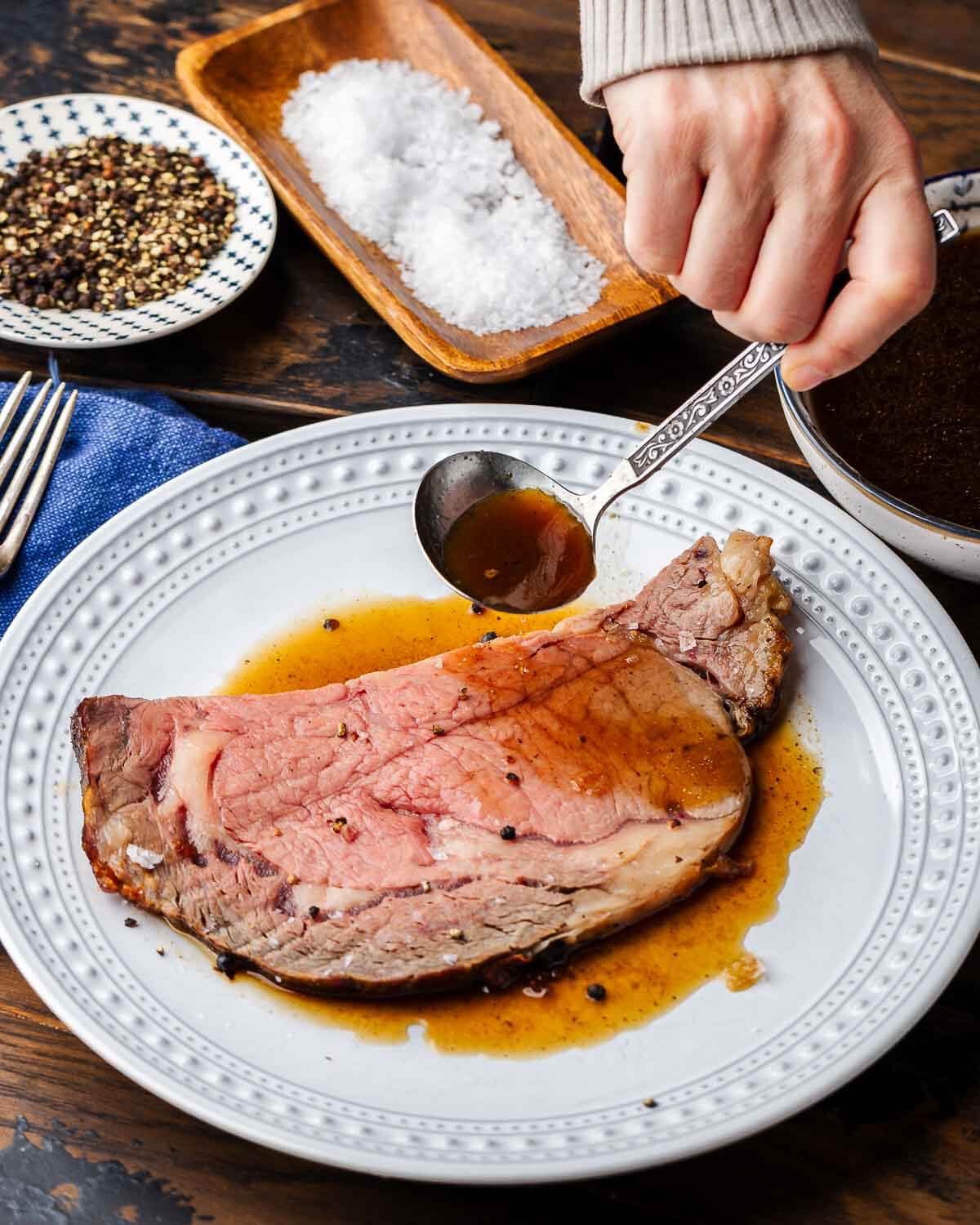
This post may contain affiliate links. Our disclosure policy.
When Christmastime rolls around I can’t help but get excited for all the food.
The cookies, feast of the seven fishes, and more, but the one meal that I love most is the Christmas Day Prime Rib au jus.
I’ve been making prime rib on Christmas Day for over 20 years and the low and slow method I outline below is everything you need to make a juicy medium-rare prime rib roast.
Also provided are step-by-step instructions to make the best jus for extra flavor.
I usually serve prime rib with homemade horseradish sauce, roasted garlic mashed potatoes, and a side of roasted Brussels sprouts and carrots.
Recipe Ingredients
All ingredients for this recipe are shown in the pic below and special notes are made in this bulleted list to assist you.
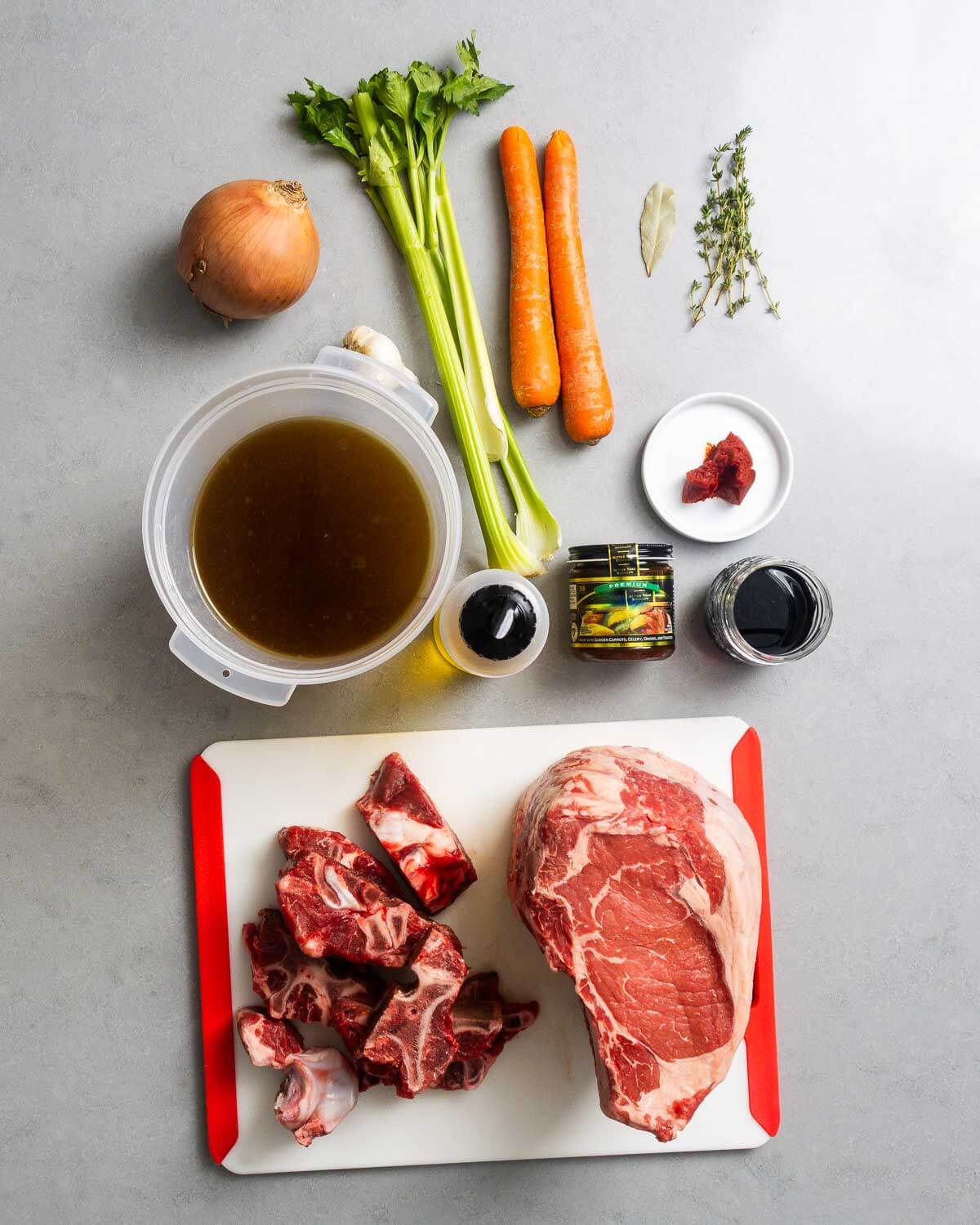
- Prime rib roast. This recipe is for a 6-pound rib roast, but you can use a larger one too but the cooking time will be longer. A 6-pound roast will usually contain 2 bones and is enough to serve 6 people. We used a USDA choice roast for this recipe. Prime-grade meat (not to be confused with prime rib) will be more expensive than choice grade. Also, a first cut that comes from ribs 10-12 contains a larger section of the rib-eye which is more uniform and tender. All this being said, a quality rib roast cooked low and slow and seared to finish will be excellent regardless of the exact cut you purchase.
- Kosher salt. For dry brining the prime rib.
- Beef bones. For the au jus, use meaty beef bones such as neck bones or oxtails.
- Beef stock. Use homemade if you can, otherwise use beef stock made from a low-sodium beef base such as Better Than Boullion brand.
- Aromatics. Carrots, celery, onion, thyme, and bay leaf for extra flavorful au jus.
- Red wine. Use a dry red wine such as Cabernet or Merlot for the au jus.
See the recipe card for complete information on ingredients and quantities.
Want To Save This Recipe?
How to roast a prime rib
Each number corresponds to the numbered written steps below.
- Note: Skip steps 1 and 2 if you had your butcher remove and tie the roast. With a sharp knife remove the bottom portion of a 6-pound roast and ribs. (Photo #1)
- Place the rib section back under the roast and tie the roast tightly back up. This will make it easier to carve the roast later on. Alternatively, you can omit these two steps and roast the prime rib as is. (Photo #2)
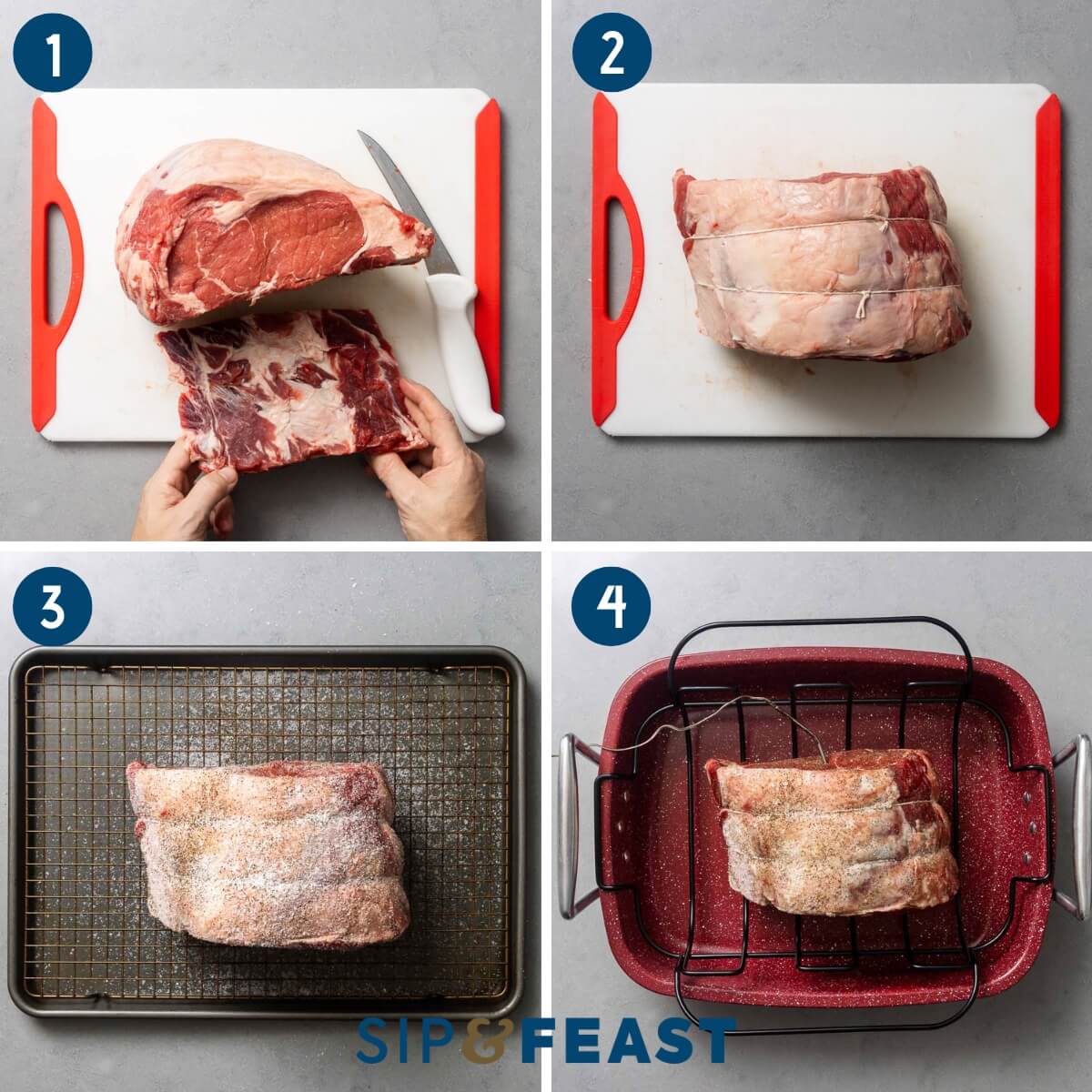
- Place a 6-pound rib roast on a wire rack lined baking sheet and season on all sides using 3 tablespoons of Diamond kosher salt (or 2 tablespoons of Morton’s kosher salt), and 1 tablespoon of coarsely ground black pepper. Place uncovered in the refrigerator and allow it to sit overnight or even better for 2 nights. (Photo #3)
- 4-5 hours before cooking, remove the prime rib from the fridge to bring it close to room temp for more even cooking. Preheat the oven to 250f and set the rack to the middle level. Place the prime rib on the rack of a roasting pan with a wire insert, fat side up, and insert a digital oven-safe thermometer into the center of the roast. Set the probe to go off when the roast reaches 120f. (Photo #4)
- Place the roast in the oven and remove once 120f is reached. This should take anywhere from 2 1/2 – 3 1/2 hours. Lightly tent the cooked rib roast with foil and allow it to rest for 30 minutes. (Photo #5)
- While the prime rib rests, set one oven rack to the lowest level and line it with foil. (This will help prevent drippings hitting the oven deck which can create smoke and set off your fire alarm). Set the second rack to the middle level and turn on the broiler. After 30 minutes of resting carefully broil the roast on the middle level until well browned on all sides (about 2 minutes per side) using tongs to maneuver the roast. Remove it from the oven and set it on a carving board. (Photo #6)
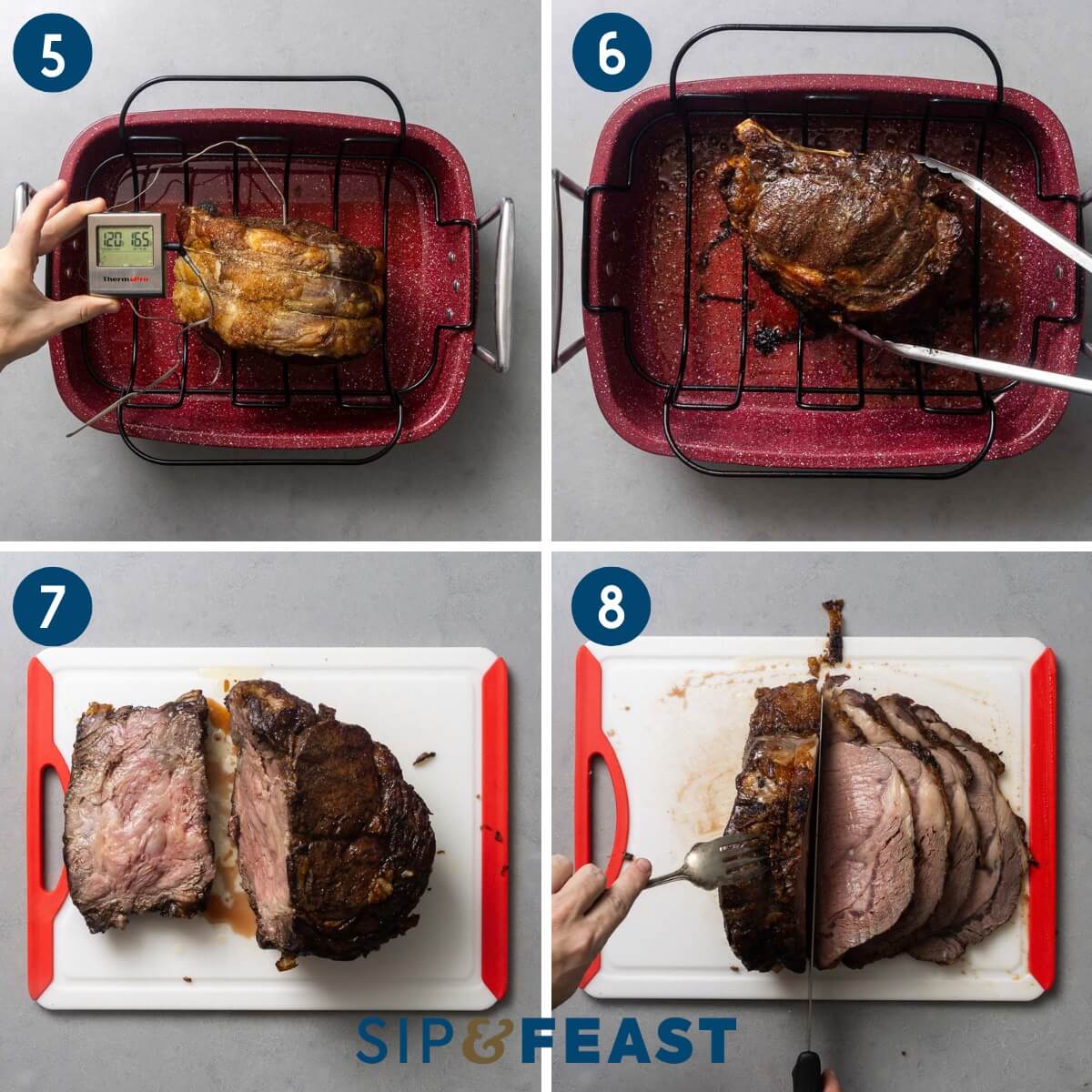
- Remove the strings and the bones. Since the roast has already rested you can carve it immediately. (Photo #7)
- Use a sharp carving knife or slicing knife (this is the slicing knife I use) to slice the roast into pieces. Serve with au jus and/or horseradish sauce and enjoy! (Photo #8)
How to make the jus
Note: Begin making the au jus right after placing the prime rib in the oven. 3 hours is more than enough time to make a delicious au jus.
Each number corresponds to the numbered written steps below.
- Chop 2 large carrots, 3 ribs of celery, and 1 large onion. Heat a large heavy pot or Dutch oven to medium heat and add 3 tablespoons of olive oil. Use a paper towel to dry off 3 pounds of bones (you can use oxtail, beef neck bones, or other meaty beef bones), then add them to the pot and brown on all sides, about 10-15 minutes. (Photo #1)
- Add 1 tablespoon of tomato paste along with the onions, celery, carrots, and a pinch of salt, and cook until the vegetables are soft, about 10 minutes. Add 5 cloves of garlic and cook for another 1-2 minutes. (Photo #2)
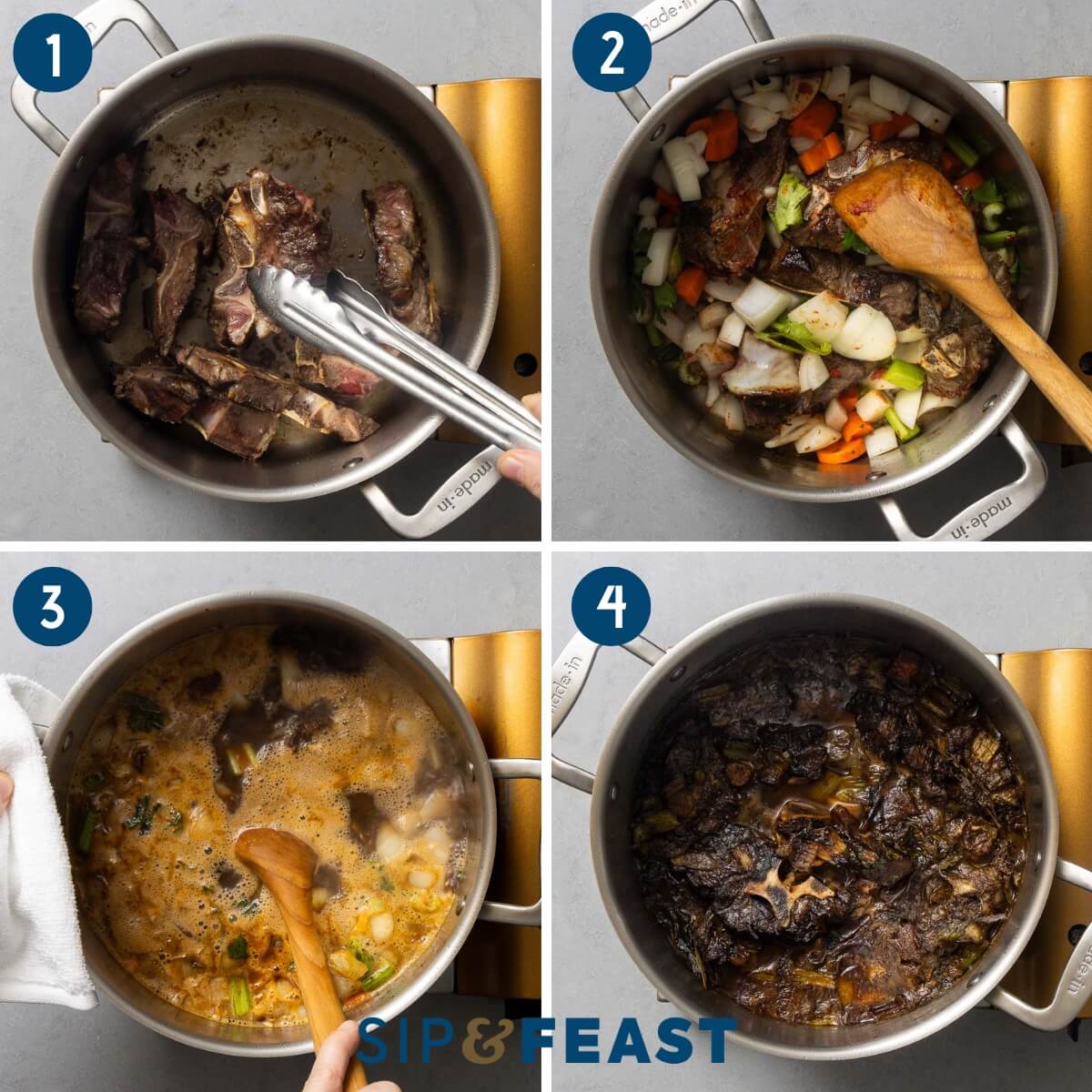
- Add 1/2 cup of dry red wine, 6 cups of homemade beef stock (or store-bought low-sodium beef stock), 1 teaspoon of Better Than Boullion beef base, 2 sprigs of thyme, and 1 large bay leaf, and bring to a boil. While boiling, use a wooden spoon to dislodge any brown bits from the bottom of the pan. Note: if using homemade beef stock, just add 1 teaspoon of beef base. If not using homemade beef stock, just use 6 cups of the beef stock using the reduced sodium Better Than Boullion beef base in accordance with the package instructions (Photo #3)
- Reduce the heat to a very low simmer and cook uncovered until the roast is finished. (Photo #4)
- Strain the au jus through a fine mesh strainer into a separate bowl. After straining the au jus, it can be covered or kept warm in a saucepot over very low heat while waiting for the prime rib drippings in step 6 below. (Photo #5)
- Place the roasting pan on a burner and turn the heat to medium-high. Ladle enough of the strained au jus into the roasting pan to deglaze. Dislodge any brown bits by scraping the pan with a wooden spoon. (Photo #6)
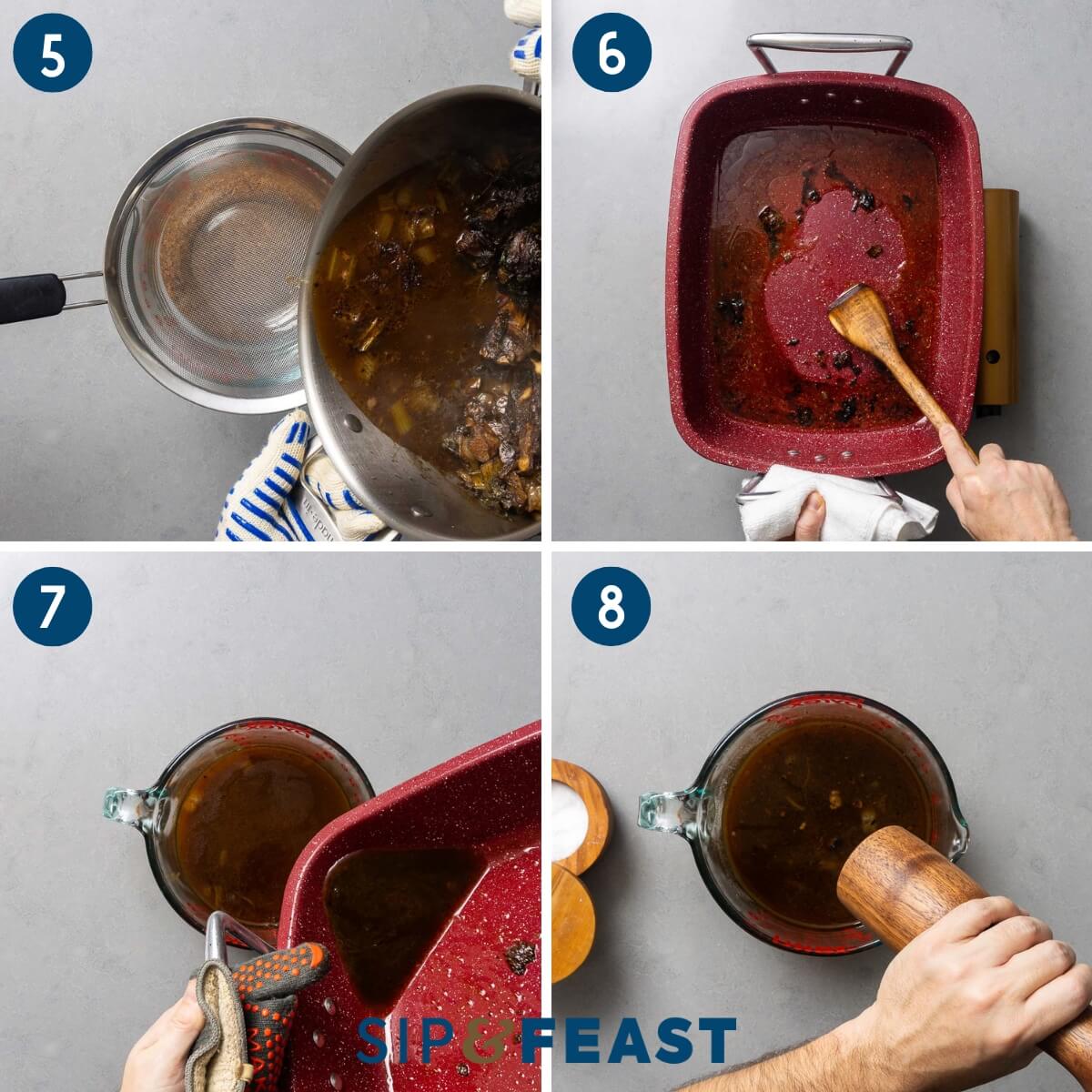
- Pour the pan drippings back into the bowl with the au jus. (Photo #7)
- Taste test and season with salt and pepper before serving the prime rib with au jus. Note: The au jus can be defatted, by skimming the fat off that rises to the top. You can de-fat with either a ladle, paper towels, a slice of bread, or by using a fat separator. (Photo #8)
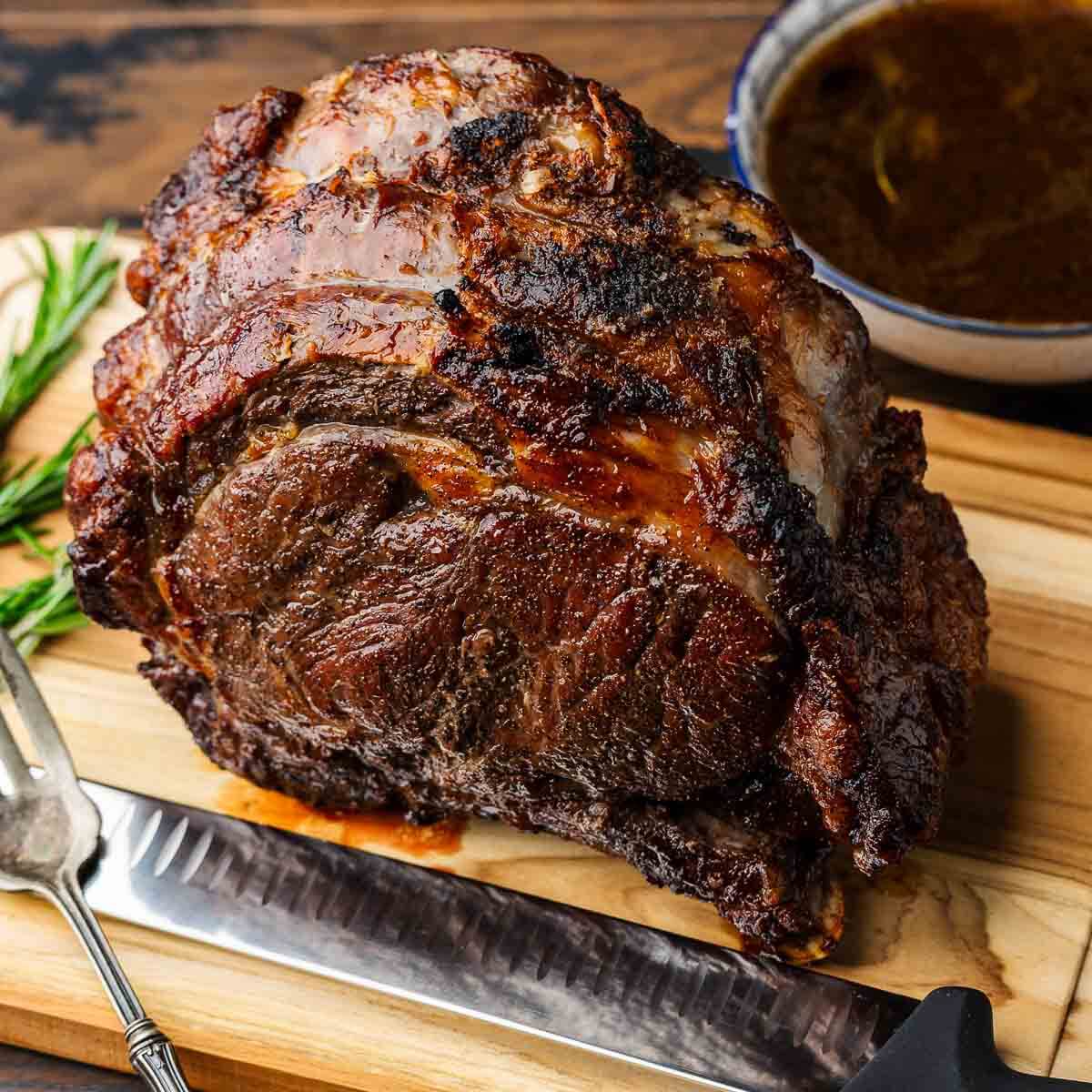
Top tips
- Use a digital meat thermometer. This will help provide precision and ensure the prime rib is cooked perfectly. I personally like using a combination of an oven-safe thermometer and using a separate instant-read digital thermometer to double-check the temperature of the roast once it’s out of the oven.
- Broiling. The process of broiling the roast on all sides can create smoke so be aware that it may set off a smoke alarm. Lining the bottom of the oven with foil can help mitigate this. If you have someone who can help you maneuver the roast while it broils, that would be ideal. Alternatively, if you have access to an outdoor grill, you can simply use the grill to sear the roast on all sides instead of using the broiler. This will eliminate the chance of smoke in your oven.
- Use homemade stock. Not only does homemade beef stock afford you better control of sodium levels, it instantly elevates the taste and flavor of any recipe.
- Talk to your butcher. To save some work, ask your butcher to cut and tie up the bones. This will allow you to skip steps 1 and 2 from above.
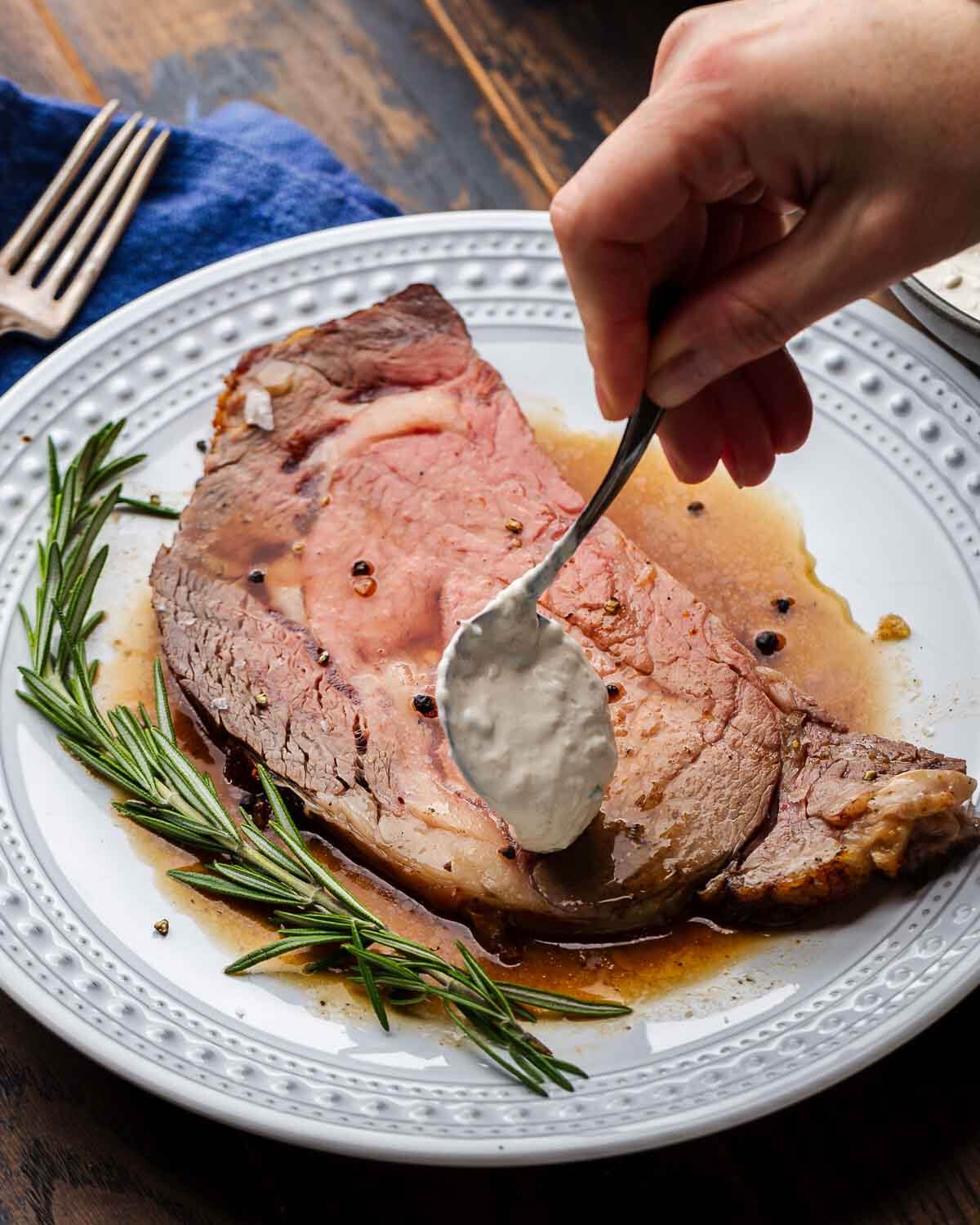
More holiday roast recipes
If you’ve enjoyed this Prime Rib Au Jus Recipe or any recipe on this site, give it a 5-star rating and tell us about it in the comments below.
We strive to satisfy a number of learning styles. If you are someone who prefers to learn by watching, you can find most of our recipes on YouTube and our Facebook Page.
Prime Rib Au Jus
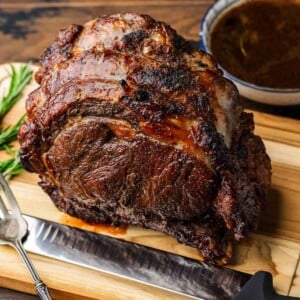
Ingredients
- 1 6 pound (2.7kg) Prime rib or beef rib roast rib bones removed and tied back up (ask the butcher)
- 3 tablespoons (30g) Diamond Crystal Kosher salt or 2 tablespoons Morton's Kosher salt
- 1 tablespoon (8g) coarse black pepper
For the au jus
- 3 tablespoons (45g) olive oil
- 3 pounds (1.4kg) oxtails, neck bones, meaty beef bones
- 1 teaspoon Better than Bouillon beef base see notes below
- 6 cups (1.4kg) low-sodium beef stock
- 1/2 cup (120g) dry red wine
- 5 cloves garlic
- 2 large carrots chopped
- 3 ribs celery chopped
- 1 large onion chopped
- 1 tablespoon (15g) tomato paste
- 2 sprigs thyme
- 1 large bay leaf
- salt and pepper to taste
Want To Save This Recipe?
Instructions
Salt 1 day before
- Season the roast with salt and pepper on all sides then place on a wire rack lined baking sheet and refrigerate uncovered overnight.
Roast the prime rib
- 4-5 hours before cooking, remove the prime rib from the fridge to bring it close to room temp for more even cooking.
- Preheat the oven to 250°F and set the rack to the middle level. Place a digital probe into the center of the roast and set it to go off at 120°F.
- Place the roast in the oven and remove once the roast achieves 120°F (anywhere from 2 1/2 – 3 1/2 hours). Lightly tent the roast with foil for 30 minutes.
- Set one oven rack to the lowest level and line it with foil (to prevent drippings from smoking and setting off the fire alarm). Set the second rack to the middle level and turn on the broiler.
- Broil the roast on the middle level until well browned on all sides (about 2 minutes per side – use tongs to move) then remove from the oven and set it on a carving board. Remove the strings and bones and slice the roast into pieces. Enjoy!
Meanwhile, make the au jus during the roasting process
- Heat a large heavy pot or Dutch oven to medium heat. Add the olive oil to the pot. Dry off the bones with paper towels then add them to the pot and brown on all sides (about 10 minutes).
- Add the tomato paste, onion, carrot, celery, and a pinch of salt to the pot and cook for 10 minutes or until soft then add the garlic and cook for another 1-2 minutes.
- Add the wine, beef base, beef stock, and herbs to the pot and bring to a boil. Dislodge all of the brown bits from the pot with a wooden spoon. Once boiling, lower to a simmer and cook uncovered until the roast is finished.
- Strain the au jus through a fine mesh strainer. Add a ladle of the au jus to the roasting pan to deglaze and dislodge any brown bits, then pour the drippings from the roasting pan into the au jus. Taste test and season with salt and pepper before serving with the Prime rib.
Notes
- If using homemade beef stock, only use 1 teaspoon of beef base. If not using homemade beef stock, use 6 cups of mixed beef stock from reduced sodium Better than Bouillon beef base.
- The exact cooking time will vary based on the size of a roast. For an almost 7 pound roast, our cooking time to 120°F took exactly 3 hours.
- A bone-in roast will serve approximately 1 person per pound, so a 6-pound bone-in roast would serve 6, and so forth.
- Use a meat thermometer for the utmost precision for a perfectly cooked roast.
- Leftovers can be saved for up to 3 days in the fridge and can be reheated covered with foil in a 275°F oven until warm.
- Almost all commercially sold rib roasts will be sold with the chine (part of the backbone) removed. If you come across a roast sold with the chine bone you should ask the butcher to remove it since it needs to be cut off with a meat bandsaw. The rib bones should be saved and tied back onto the roast. Again, ask your butcher.
Nutrition
Nutrition information is automatically calculated, so should only be used as an approximation.
Follow Me







We love au jus! Thanks for the recipe! 😊
So happy you enjoyed, Ellen!
A 2 bone rib roast took over 4.5 hours to get to 200 degrees at 250. eating after 9pm was awful. I won’t do this recipe again.
Hi Art, sorry to hear you didn’t have success with the recipe. You mention 200°F, but our instructions are to remove the roast when it reaches 120°F, then allow it to rest and then broil on all sides. 200° is far beyond well-done, which is 160-165°F and our instructions were really for rare to medium rare.